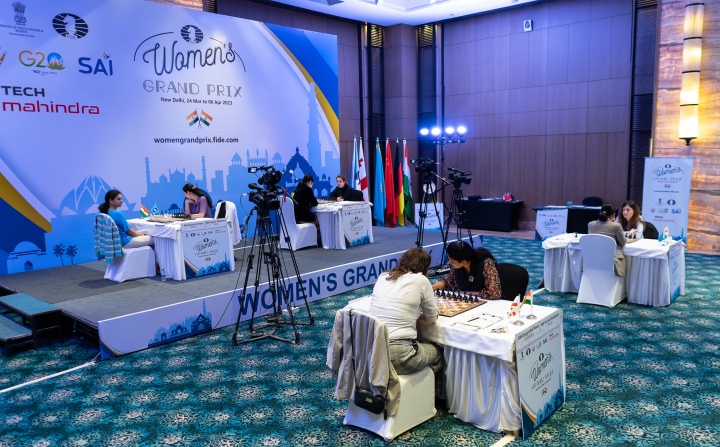FIDE Women’s Candidates Final 2022-2023 kicks off in Chongqing

On March 28th, a press conference was held at the Wyndham Hotel Chongqing Yuelai for the final of the “Liangjiang New Area” Cup 2022-2023 FIDE Women’s World Championship Candidates Tournament. FIDE President Arkady Dvorkovic, FIDE Vice President Xie Jun, FIDE treasurer Zhu Chen, the local leaders, and the two players Tan Zhongyi and Lei Tingjie answered questions from the media. FIDE President Dvorkovic said: “The fact that the two Chongqing players met in the final is a major victory for Chinese women chess players. I think such a victory is not an accident; it is the result of the tireless efforts of Chinese chess, both individually and as a team. We all remember that the Chinese men’s and women’s teams both won the 2018 Olympiad, and the Chinese men’s team won the World Team Championship in Israel last year. This year, FIDE’s two world championships will feature three Chinese players, which is a remarkable achievement. This achievement is the result of a good and continuous tradition of chess development in China and is the result of the systematic development of chess in all major cities in China. At present, China has joined Russia, India and the United States as a chess superpower.” Then FIDE treasurer and former women’s world champion Zhu Chen said: “In my life, chess has been the best teacher. When I encountered difficulties, I was able to guide my way through life by playing chess. I think all chess players will feel the same as me and will gain from chess. The development of chess in Chongqing is obvious, and Chinese players have been working very hard, and our young players have been working twice as hard. Therefore, I am confident in the development of our chess players, including the young players.” Four-time World Champion and FIDE Vice President Xie Jun said: “I am very happy to be here today for the press conference. I would like to thank FIDE for organizing so many important tournaments so that players can be trained, and I would also like to give special thanks to the Chinese Chess Association, both for the establishment of the national team and for the tournaments at all levels in our provinces and cities, which allow our players to have more opportunities and to grow continuously. Now already, we have made the world championship a national championship and let people witness the achievements of Chinese chess. This is the glory of Chinese chess!” The two finalists also answered questions from journalists. Former world champion Tan Zhongyi said, “Compared to playing hundreds of games with Ju Wenjun, Lei Tingjie and I were teammates in Chongqing, so we have had fewer games with each other, and were a kind of ‘most familiar strangers’. So I thought this match with Lei would be more interesting.” Lei Tingjie said: “This tournament is a little bit closer to my dream. For every player, the world championship is the ultimate goal. I hope I can focus on the tournament. I am happy that all three of us (and Ju Wenjun) are Chinese women players, and it is a special pride that the future queen title belongs to us in China, and of course I hope to stay in Chongqing”. At the drawing ceremony, Tan Zhongyi drew the white pieces in tomorrow’s first round. The first game will be played at 3:00 pm local time on March 29th. You can follow all the games with live commentaries on the FIDE YouTube Channel. Text: Gu Xiaobing Official website: womenscandidates.fide.com/
Women’s Grand Prix New Delhi: Round 3 recap

With a second consecutive victory, Bibisara Assaubayeva is in the lead after three rounds of the Women’s Grand Prix Assaubayeva had a lucky break after Nino Batsiashvili made a blunder in an even position and lost. Assaubayeva now shares first place with Alexandra Goryachkina who is also on two points, but who had a free point today as she wasn’t playing. The two will be facing each other in the fourth round. Kateryna Lagno and Harika Dronavalli both surprised their opponents in today’s round but that wasn’t good enough for a victory. While Lagno, playing as Black, had more chances and initiative after some imprecisions from her opponent Humpy Koneru, it wasn’t enough. On the other hand, Harika was happy to draw with her friend and well-known competitor Nana Dzagnidze having surprised her with the opening choice. The longest game of the day was between Zhu Jiner of China and Polina Shuvalova. Following a dynamic game, the two ended in a drawn rook endgame which lasted until the 87th move. Here follows a recap of today’s games. Humpy Koneru – Kateryna Lagno Humpy and Lagno have played 39 games until now, and all have been Gruenfield or Benoni. However, in this game, Lagno decided to go for the Semi-Tarrasch line of the Queen’s gambit declined, surprising her opponent. “I felt that she was surprised”, said Lagno afterwards. Following the opening, the two reached the following position. Here Humpy opted to open the centre, probably somewhat prematurely: 11.e4 dxe4, and White immediately pressed on: 12.d5 Bc3 13.dxe6 Bxd2 14.Qxd2. However, after 14…Ne5! 15.Qf4 and Black emerged slightly better, threatening to put her knight on d3, which could be fatal for White. Harika decided to give up the e6 pawn but after 16.Rfd1 Qxe6 17.Bxf6 Qxf6 18.Qxe4 had to switch to defence as Black enjoyed some edge because of the stronger knight and an extra pawn. Black’s chances of putting more pressure were hanging on keeping the e5-knight which protected the c4-pawn. Lagno decided to plant the knight on d3, where it was immediately traded. Although White could not take the d3-pawn immediately due to the weakness of her b2-pawn, Humpy made a couple of consolidating moves first and only after that restored the material balance with a completely even position. More exchanges followed, leading to a drawn queen’s endgame. Both are now on 1,5 out of three. Zhu Jiner – Polina Shuvalova Zhu offered to battle in the Italian Game, but Shuvalova opted for the quieter line with the bishop on e7 (known as the Hungarian Defence) with an early d7-d5. On move 12, White struck in the centre and decided to play with the isolated d-pawn, which Black zeroed in on immediately. In the subsequent maneuvering play, both opponents traded slight inaccuracies in a roughly equal position, but it was Shuvalova who made a serious one first. After 22…Be7? (22…c5 was a much better alternative). White is much better: she can exchange the bishops and then centralise the queen on d4 and continue with the advance on the kingside. Instead, Zhu decided to avoid the exchange with 23.Bg3? thus allowing breathing space for Black. In a dynamic position that emerged, Zhu pressured on the right flank while Shuvalova was countering on the queenside. Black had to be more cautious as White pushed, but Shuvalova demonstrated good calculation, steering to an endgame despite being down a pawn. As soon as the queenside pawns were exchanged, Black was out of trouble. Still, Zhu tested her opponent in a drawn three-vs-two paws on one side rook endgame for another 46 moves. Having finally exhausted all options, the two agreed to split a point after four and a half hours of play. Both Zhu and Shuvalova are on 1,5 points after the first three rounds. Nana Dzagnidze – Harika Dronavalli The game began with a surprise: As Nana confessed later, Harika’s second move 1.d4 d5 2.c4 c6, was something she didn’t expect. “We are friends, and we played many games together, but Harika never ceases to surprise with her openings,” said Nana in the post-game interview. The two followed the main moves of the exchange variation of the Slav Defence, which does not offer much for White. The game was mostly calm, with a flicker of excitement seen after White’s 18th move. White just played 18.e4 aiming to make a push through the centre. Dronavalli responded with 18…Re8. Here Dzagnidze opted for innocuous 19.Rc2, while a stronger move was 19.Rfd1, building up the pressure on the centre. However, Nana did not feel she had achieved much and was overall not happy with her position. With this in mind, she soon offered a move repetition. Dronavalli was comfortable with a draw as Black, so the two called it a day after 25 moves and two and a half hours of play. Both Dzagnidze and Dronavalli are now on 1,5 points after three rounds. Bibisara Assaubayeva – Nino Batsiashvili Bibisara Assaubayeva scored her second consecutive victory in the Women’s Grand Prix in New Delhi, having defeated Nino Basiashvili. Assaubayeva has now extended her lead against Batsiashvili to 4:1. In a popular line of Tarrasch Defence tested extensively over the last few years on the highest level, Black sacrificed a pawn but got sufficient compensation. The two soon headed into an endgame, and that’s when things took an unpleasant turn for Nino. White has an extra pawn on a4, but Black has more activity and can pose some threats to the king. The position was equal until this moment when Batsiashvili made a terrible blunder Rxa4?? Bibisara naturally responded with 31.Nc5, winning an exchange. To make things even worse, Batsiashvili played 31…f6, weakening the seventh rank, which made her position absolutely hopeless. The rest was a smooth sail of Bibisara, who easily converted her extra material. Batsiashvili now has 1,5 points, while Assaubayeva has two victories from two games played so far. Standings after the third round: Bibisara Assaubayeva – 2 pointsAlexandra Goryachkina – 2 pointsHarika

